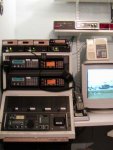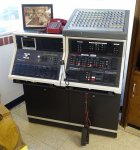The CentraCom-II dispatch console was sold by Motorola in the 1970’s thru the 1990’s and was intended for 9-1-1 centers and other dispatch operations. The classic version of the CentraCom, called “Buttons and LEDs” (“B&L”) had a distinctive white and black aesthetic with red LED indication lights. Most systems were equipped with a backroom rack called a CEB (Central Equipment Bank) that interfaces with the radios, phone systems etc., all connected via large 100-pair cables and punch downs.
These consoles were a great example of industrial design and were pretty much the standard to be followed for dispatch centers in the era before computers took over. With white enamel counter-tops, white trim and buttons and black panels, it offered an attractive and durable appearance. It was the top-selling console system of its type then, competing with offerings from ModuCom, OrbaCom, General Electric and others. Motorola and GE built their own furniture then while smaller vendors supplied third-party products, often that emulated the CentraCom look and arrangement.
Mechanically the furniture was a steel frame cabinet with removable doors on the front, rear and sides as well as removable top panels. It was all modular with various configurations that allowed one to select from an endless variety of configurations, from a single bay to a dozen seats with several bays per seat. Each section had open frames to allow wires to pass thru, only the exterior sections would have doors or panel covers.
The base (below the desktop) furniture included rails for power and control equipment to be mounted and the operations bays (above the desktop facing front) also had rails for console panels and other equipment. Trim pieces covered the exterior edges to hide the machine screws for a professional appearance.
The control bays had angled lower bay and vertical upper bay sections of various sizes. Short (4u) angled or vertical bays allowed monitors to be placed on top of them while larger sections held the control panels or allowed larger equipment installations. A common configuration consisted of a central bay with a short arrangement for a computer monitor and taller bays to the left and right. Larger arrangements included angled corner pieces to provide wrap-around or angled desktops and rack panels. Often these corner pieces had the microphone arms mounted on them to make use of otherwise wasted space.
Since most dispatch centers, even then, had computer monitors and other equipment to consider the bays used 19-inch rack sizing with different height options to allow use of industry-standard equipment including alarm panels, phone options and other radio equipment. It is this that makes these widely sought after today for scanner and ham radio enthusiasts.
The console system included white enamel covered desktops sized to fit the provided furniture. These were designed to hold up to 24/7 use and the inevitable coffee stains cleaned up nicely with a quick shot of glass cleaner and a paper towel.
The aesthetics, durability and mechanics of the CentraCom furniture make it ideal to house ham radios, scanners and the various accessories and computers in a modern ham shack. Since almost anything can be mounted to a standard 19-inch rack these days, the sloped main panel and vertical accessory panels are great for mounting gear.
The control system itself is pretty limited in usefulness as it is all a hard-wire connection. It is the furniture that is the real prize. Some enterprising souls have been able to use some of the controls by re-wiring them. The speakers and mics are often reusable in modern shacks as well. Several companies, such as NovexComm, make rack mounting gear for modern radios.
Some 20 years ago a friend who was managing a 9-1-1 center was replacing his old CentraCom II B&L system with a new computerized system and asked if I wanted their CentraCom. He had 2 seats, each with 6 sections, 2 corners and a variety of low and high bay sections as well as the CEB and associated equipment, pretty much everything but the radios, and I probably could have had those too if I really wanted.
At the time however I lived in a fairly small townhouse and did not have the room to store or install it. I did take 2 small sections and used it to hold some of my radios for several years. If he asked me today I would be there before he could hang up the phone with a rented truck and taken the whole system.
My current shack consists of a full-sized network cabinet with various scanners and ham radios rack-mounted in it. This same gear would move into a CentraCom console perfectly if I had one. The one my friend offered me years ago would have been ideal now that I have the room to appreciate it. The ideal setup for a home ham or scanner shack would be a 5-bay corner system with 3 short stacks surround by a pair of tall stacks. This would allow a couple computer monitors to be front and center and give plenty of room to rack-mount gear. The wiring would all be contained and hidden. With plenty of speakers to connect to various radios and the bulletproof Motorola power supply it would all be pretty much self-contained save for the antennas.
Do a Google search for CentraCom II and enjoy the many photos of these console systems. You will have to appreciate the aesthetics of the furniture. While I was never a big fan of the sometimes complicated operation of the systems, the furniture was a thing of beauty. If you are a ham or scanner guy with compatible radios and have the chance at acquiring one of these you will be a happy guy.

The one CentraCom bay I had room for held an R7000 as well as other radios "back in the day"... Since I did not have the desktop I filled the space with a piece of a yardstick that was later painted to match.
These consoles were a great example of industrial design and were pretty much the standard to be followed for dispatch centers in the era before computers took over. With white enamel counter-tops, white trim and buttons and black panels, it offered an attractive and durable appearance. It was the top-selling console system of its type then, competing with offerings from ModuCom, OrbaCom, General Electric and others. Motorola and GE built their own furniture then while smaller vendors supplied third-party products, often that emulated the CentraCom look and arrangement.
Mechanically the furniture was a steel frame cabinet with removable doors on the front, rear and sides as well as removable top panels. It was all modular with various configurations that allowed one to select from an endless variety of configurations, from a single bay to a dozen seats with several bays per seat. Each section had open frames to allow wires to pass thru, only the exterior sections would have doors or panel covers.
The base (below the desktop) furniture included rails for power and control equipment to be mounted and the operations bays (above the desktop facing front) also had rails for console panels and other equipment. Trim pieces covered the exterior edges to hide the machine screws for a professional appearance.
The control bays had angled lower bay and vertical upper bay sections of various sizes. Short (4u) angled or vertical bays allowed monitors to be placed on top of them while larger sections held the control panels or allowed larger equipment installations. A common configuration consisted of a central bay with a short arrangement for a computer monitor and taller bays to the left and right. Larger arrangements included angled corner pieces to provide wrap-around or angled desktops and rack panels. Often these corner pieces had the microphone arms mounted on them to make use of otherwise wasted space.
Since most dispatch centers, even then, had computer monitors and other equipment to consider the bays used 19-inch rack sizing with different height options to allow use of industry-standard equipment including alarm panels, phone options and other radio equipment. It is this that makes these widely sought after today for scanner and ham radio enthusiasts.
The console system included white enamel covered desktops sized to fit the provided furniture. These were designed to hold up to 24/7 use and the inevitable coffee stains cleaned up nicely with a quick shot of glass cleaner and a paper towel.
The aesthetics, durability and mechanics of the CentraCom furniture make it ideal to house ham radios, scanners and the various accessories and computers in a modern ham shack. Since almost anything can be mounted to a standard 19-inch rack these days, the sloped main panel and vertical accessory panels are great for mounting gear.
The control system itself is pretty limited in usefulness as it is all a hard-wire connection. It is the furniture that is the real prize. Some enterprising souls have been able to use some of the controls by re-wiring them. The speakers and mics are often reusable in modern shacks as well. Several companies, such as NovexComm, make rack mounting gear for modern radios.
Some 20 years ago a friend who was managing a 9-1-1 center was replacing his old CentraCom II B&L system with a new computerized system and asked if I wanted their CentraCom. He had 2 seats, each with 6 sections, 2 corners and a variety of low and high bay sections as well as the CEB and associated equipment, pretty much everything but the radios, and I probably could have had those too if I really wanted.
At the time however I lived in a fairly small townhouse and did not have the room to store or install it. I did take 2 small sections and used it to hold some of my radios for several years. If he asked me today I would be there before he could hang up the phone with a rented truck and taken the whole system.
My current shack consists of a full-sized network cabinet with various scanners and ham radios rack-mounted in it. This same gear would move into a CentraCom console perfectly if I had one. The one my friend offered me years ago would have been ideal now that I have the room to appreciate it. The ideal setup for a home ham or scanner shack would be a 5-bay corner system with 3 short stacks surround by a pair of tall stacks. This would allow a couple computer monitors to be front and center and give plenty of room to rack-mount gear. The wiring would all be contained and hidden. With plenty of speakers to connect to various radios and the bulletproof Motorola power supply it would all be pretty much self-contained save for the antennas.
Do a Google search for CentraCom II and enjoy the many photos of these console systems. You will have to appreciate the aesthetics of the furniture. While I was never a big fan of the sometimes complicated operation of the systems, the furniture was a thing of beauty. If you are a ham or scanner guy with compatible radios and have the chance at acquiring one of these you will be a happy guy.

The one CentraCom bay I had room for held an R7000 as well as other radios "back in the day"... Since I did not have the desktop I filled the space with a piece of a yardstick that was later painted to match.


